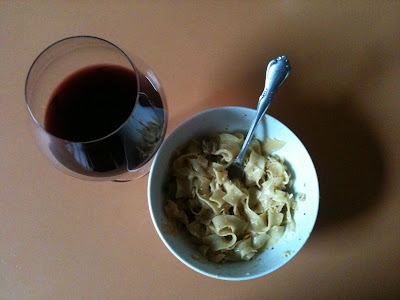Tuesday, September 6, 2011
'Lalama' 2006
Beautiful rainy day, the rain for a few minutes there like spikes, crystalline bars. The hinge between summer and fall is bending, the muffled sounds of trucks and traffic noise are a quiet muffled hum from my treetop perch. With so many ideas swirling in my head, I am trying to find the thread, the common theme. I have been thinking about fire, and brimstone this morning. And then it rained. It quieted my ruffled Aries feathers, safe and contained, under blankets I feel at peace. The best writing times are when three things intersect: rain outside, a desire, no NEED to cook for myself, and a bottle of wine that I have never tried before. Sometimes it is hard to capture these trisected moments in words, sometimes I just take photos and leave it at that, but today I thought I would at least focus on some of the details.
Rainy days in the city are of course, the best days for cooking. One good chef's knife, oft-used thick cutting board and well-seasoned cast-iron pan are the only tools I think I will ever need. So, this afternoon, I just made a favorite version of a much-used go-to comfort pasta: sauteed onions (sweet), salt, carmelize in cast iron pan in olive oil and butter, add farmer's market elephant garlic for a minute, deglaze with white wine, chicken stock, copious black pepper, green olives, simmer, add freshly cooked egg noodles, marry together in cast iron, add to bowl with a fair amount of grated parmesan, stir, watch it quietly steam on the table, eat.
With my pasta I wanted to try a new wine, 'Lalama' 2006 from Dominio do Bibei in Ribera Sacra, Spain. Dominio do Bibei is located in the Quiroga-Bibei sub zone of the Ribeira Sacra D.O. The Quiroga-Bibei zone is more harsh, dry, an hot than the others in this zone, but still a part of the high altitude mountains and rivers of the D.O. Winemaker Javier Dominguez is returning to the old methods of winemaking, and trying to uncover the bones of an older vineyard, to gain the tactile and specific understanding of his land with as much non-interventionist method as possible-- cement and wood only, no stainless. Hand-harvesting is a pre-requisite in these steep vineyards.
According to Tom Delorme:
http://personalwinebuyer.com/2010/06/07/dominio-do-bibei-ribeira-sacra-lalama-2006/
"The vineyards are still tremendously steep and tremendously difficult to navigate. Planted on these terraces are old vines of Mencía, Garnacha, Brancellao and Mouraton. New plots are being planted using cuttings from these old vines to maintain diversity in the vineyard. In addition to the red varietals, there are plantings of white grape varieties such as Doña Blanca, Godello and Albariño (the cuttings of this last grape being from Do Ferreiro). 'Lalama' is a combination of parcels and is comprised of 85% Mencia with 7% Garnacha, 6% Brancellao (aka Albarello that grows in Galicia and Portugal) and 2% Mouraton (too obscure to even make the Oxford Companion to Wine). Vine age is a range of 15 to 100 years old. Harvest was done by hand and the grapes were harvested separately by variety."
With my pasta, it seems a heavy pair at first, yet is surprisingly good with this light/white/green dish. The sweetness of the onions really brought out the pepper in the wine, and the cheese and egg noodle creaminess is cut by the spice of the wine. I keep getting layers of different kinds of ground pepper: black, pink, white, but also an underlying base of heavy fruit (raspberry, cherry). There is a defined round morello cherry on the nose and first taste, the finish is amazing in its depth and earthy, spicy layers. This (mostly) Mencia is not as concentrated and chock full as some of its varietal counterparts, there is a lightness and flowing quality that does not cloy.
When first opened the bottle, I was getting a little more of the smoke and bacon fat that I love from reds of this area. Over an hour or so, the wine has mellowed into something more currant-y and slightly green, incense and just a spike of burned wood (sandelwood, cedar) at the end, lingering with some cassis and framboise perfume. The finish is complex and warming, in the way that a really good red wine just has. Maybe the lushness on the finish are indicative of the clay-rich soils that this region claims over its more slate-dominated neighbors in the Ribeira Sacra sub-zones, spiked with pinpricks of green peppercorn, plum, juniper, cardamom, and cinnamon bark. On this rainy day, I am comforted and inspired.
Subscribe to:
Post Comments (Atom)




No comments:
Post a Comment